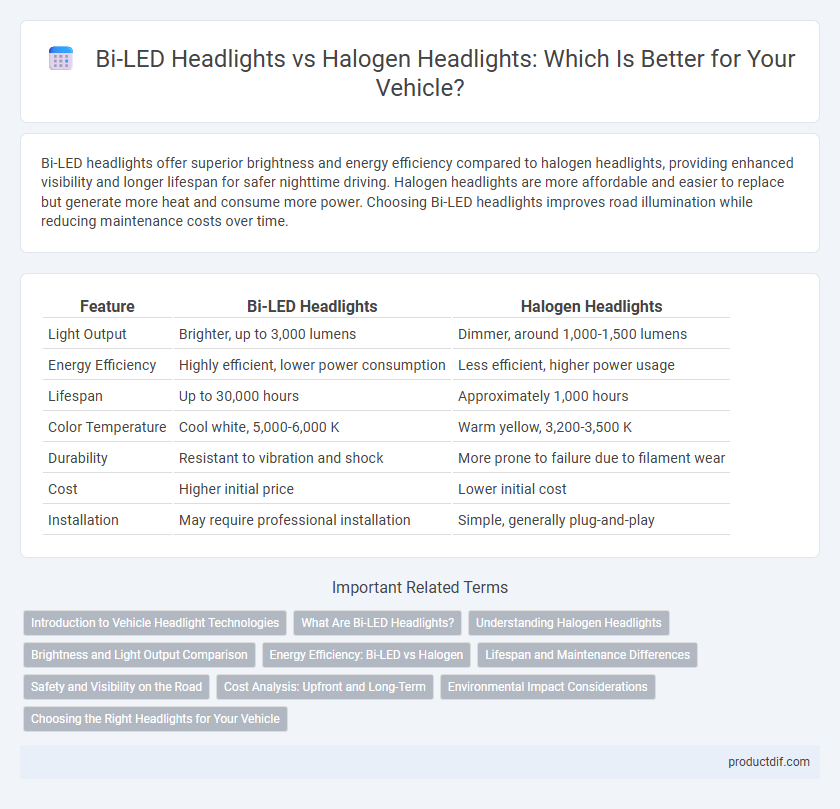Bi-LED headlights offer superior brightness and energy efficiency compared to halogen headlights, providing enhanced visibility and longer lifespan for safer nighttime driving. Halogen headlights are more affordable and easier to replace but generate more heat and consume more power. Choosing Bi-LED headlights improves road illumination while reducing maintenance costs over time.
Table of Comparison
| Feature | Bi-LED Headlights | Halogen Headlights |
|---|---|---|
| Light Output | Brighter, up to 3,000 lumens | Dimmer, around 1,000-1,500 lumens |
| Energy Efficiency | Highly efficient, lower power consumption | Less efficient, higher power usage |
| Lifespan | Up to 30,000 hours | Approximately 1,000 hours |
| Color Temperature | Cool white, 5,000-6,000 K | Warm yellow, 3,200-3,500 K |
| Durability | Resistant to vibration and shock | More prone to failure due to filament wear |
| Cost | Higher initial price | Lower initial cost |
| Installation | May require professional installation | Simple, generally plug-and-play |
Introduction to Vehicle Headlight Technologies
Bi-LED headlights utilize two separate LED chips to provide both high and low beam functions, offering brighter illumination and longer lifespan compared to traditional halogen headlights. Halogen headlights operate by passing current through a tungsten filament within a halogen gas-filled bulb, producing a warm, yellowish light with shorter durability and lower energy efficiency. Advances in vehicle headlight technologies focus on enhancing visibility, energy consumption, and safety features, with Bi-LED systems becoming increasingly popular in modern vehicles for their superior performance.
What Are Bi-LED Headlights?
Bi-LED headlights utilize two light-emitting diodes (LEDs) within a single housing to provide both high and low beam functions, delivering brighter and more efficient illumination compared to halogen headlights. These headlights offer enhanced energy efficiency, longer lifespan, and improved visibility, which contribute to safer driving conditions. Bi-LED technology also generates less heat and consumes less power, making it a superior choice for modern vehicles seeking advanced lighting performance.
Understanding Halogen Headlights
Halogen headlights use a tungsten filament enclosed in a glass bulb filled with halogen gas, producing a warm, yellowish light with moderate brightness and lifespan. They are cost-effective, easy to replace, and compatible with most vehicle electrical systems, making them common in entry-level and older vehicles. Despite lower energy efficiency and shorter durability compared to Bi-LED headlights, halogens deliver sufficient illumination for basic driving needs in urban and low-speed environments.
Brightness and Light Output Comparison
Bi-LED headlights produce significantly higher brightness levels, offering over 3,000 lumens compared to halogen headlights which typically emit around 1,000 to 1,500 lumens. The superior light output of Bi-LEDs results in enhanced visibility and longer illumination range, improving driving safety in low-light conditions. Halogen headlights generate a warmer, yellowish light with lower intensity, making Bi-LEDs the preferred choice for modern vehicles seeking efficient and bright lighting solutions.
Energy Efficiency: Bi-LED vs Halogen
Bi-LED headlights consume significantly less power compared to traditional halogen headlights, improving overall vehicle energy efficiency and reducing fuel consumption in combustion engines or extending battery life in electric vehicles. Bi-LED technology produces brighter, more focused light output while operating at lower wattage, resulting in enhanced visibility with less energy use. Halogen bulbs typically operate at higher wattage and generate excessive heat, leading to wasted energy and shorter lifespan compared to the more efficient and durable Bi-LED headlights.
Lifespan and Maintenance Differences
Bi-LED headlights offer a significantly longer lifespan, typically lasting up to 30,000 hours, compared to halogen headlights which generally last around 1,000 to 2,000 hours. Maintenance for Bi-LEDs is minimal due to their durability and resistance to heat, whereas halogen headlights require more frequent replacements and are prone to filament burnout. The extended lifespan and reduced maintenance needs of Bi-LED headlights result in lower long-term costs and enhanced reliability for vehicle lighting systems.
Safety and Visibility on the Road
Bi-LED headlights provide superior brightness and a more focused beam pattern compared to halogen headlights, significantly enhancing visibility in low-light and adverse weather conditions. Their cooler color temperature closely mimics natural daylight, improving driver reaction times and reducing eye strain on long night drives. Halogen headlights, while more affordable, often produce a yellowish light with a shorter range, which can limit the driver's ability to detect obstacles and road signs promptly.
Cost Analysis: Upfront and Long-Term
Bi-LED headlights typically have a higher upfront cost ranging from $250 to $600 compared to halogen headlights, which usually cost between $15 and $50 per bulb. Long-term expenses favor Bi-LEDs due to their superior energy efficiency and longer lifespan, often lasting up to 20,000 hours versus 450 to 1,000 hours for halogens, reducing replacement frequency and maintenance costs. Increased durability and lower power consumption contribute to overall savings despite the initial investment difference.
Environmental Impact Considerations
Bi-LED headlights consume significantly less energy than halogen headlights, reducing overall vehicle emissions and contributing to lower carbon footprints. The longer lifespan of Bi-LED units means fewer replacements, resulting in less waste and reduced resource consumption during manufacturing. Halogen headlights generate more heat and require more frequent bulb changes, increasing environmental burden due to higher energy use and disposal rates.
Choosing the Right Headlights for Your Vehicle
Bi-LED headlights offer enhanced brightness and energy efficiency compared to traditional halogen headlights, improving nighttime visibility and safety. Halogen headlights, while more affordable and easier to replace, provide a warmer light with less intensity and shorter lifespan. Evaluating factors like driving conditions, budget, and vehicle compatibility helps in selecting the optimal headlight type for your vehicle.
Bi-LED Headlights vs Halogen Headlights Infographic

 productdif.com
productdif.com